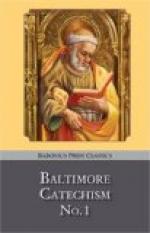The Israelites, who worshipped the true God and offered Him sacrifices because He made known to them by revelation that they should do so, had four kinds of sacrifice. They offered one for sin, another in thanksgiving for benefits received, another as an act of worship, and another to beg God’s blessing. It is just for these four ends or objects we offer up the one Christian sacrifice of the holy Mass. In the beginning the head of the family offered sacrifice—as Noe did when he came out of the Ark—but after God gave His laws to Moses He appointed priests to offer up the sacrifices. Aaron, the brother of Moses, was the first priest appointed, and after him his descendants were priests. When Our Lord came and instituted a new sacrifice He established the priesthood of the New Law, and appointed His own priests, namely, the Apostles, with St. Peter as their chief, and after them their lawfully appointed successors, the bishops of the world, with the Pope as their chief. The sacrifices of the Old Law were figures of the sacrifice of the New Law, and were to cease at its institution; and when the ancient sacrifices ceased the ancient priesthood was at an end.
265 Q. Is the Mass the same sacrifice as that of the Cross? A. The Mass is the same sacrifice as that of the Cross.
But how is the Mass a sacrifice? It is a sacrifice because at the Mass the body and blood of Our Lord are offered to His heavenly Father at the consecration, and afterwards consumed by the priest. In offering up the body and blood of Our Lord the bread and wine are consecrated separately, and kept separate on the altar at Mass to signify their separation at Our Lord’s death in the sacrifice of the Cross, when His sacred blood flowed from His body. The Holy Eucharist is also a Sacrament, because it has the three things necessary to constitute a Sacrament; namely, (1) The outward sign—that is, the appearance of bread and wine. (2) The inward grace; for it is Jesus Christ Himself, the Author and Dispenser of all graces. (3) It was instituted by Our Lord.
The Holy Eucharist is therefore both a sacrifice and a Sacrament. It is a sacrifice when offered at Mass, and a Sacrament when we receive it and when it is reserved in the tabernacle.
266 Q. How is the Mass the same sacrifice as that of the Cross? A. The Mass is the same sacrifice as that of the Cross because the offering and the priest are the same—Christ Our Blessed Lord; and the ends for which the sacrifice of the Mass is offered are the same as those of the sacrifice of the Cross.
On the Cross the offering was the body and blood of Our Lord; the one who offered it was Our Lord; the reason for which He offered it was that He might atone for sin; the one to whom He offered it was His heavenly Father. Now, at Mass it is the same. The object offered is Our Lord’s body and blood, the one suffering is Our Lord Himself, through the priest; it is offered for sin, and it is offered to the heavenly Father. All things are the same, except that the blood of Our Lord is not shed, and Our Lord does not die again.




